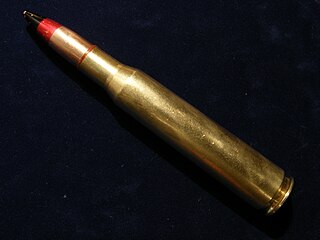In military terminology, a squad is among the smallest of military organizations and is led by a non-commissioned officer. NATO and US doctrine define a squad as an organization "larger than a team, but smaller than a section." while US Army doctrine further defines a squad as a "small military unit typically containing two or more fire teams." In US usage, a squad consists of eight to fourteen soldiers, and may be further subdivided into fireteams.
M40 or M-40 may refer to:

High-explosive anti-tank (HEAT) is a type of shaped charge explosive that uses the Munroe effect to penetrate heavy armor. The warhead functions by having an explosive charge collapse a metal liner inside the warhead into a high-velocity superplastic jet; this is capable of penetrating armor steel to a depth of seven or more times the diameter of the charge. The jet's effect is purely kinetic in nature; the round has no explosive or incendiary effect on the target.
PM or pm is an abbreviation for Latin post meridiem, meaning "after midday" in the 12-hour clock.

An anti-tank rifle is an anti-materiel rifle designed to penetrate the armor of armored fighting vehicles, most commonly tanks, armored personnel carriers, and infantry fighting vehicles. The term is usually used for weapons that can be carried and used by one person, but is sometimes used for larger weapons. The usefulness of rifles for this purpose ran from the introduction of tanks in World War I until the Korean War. While medium and heavy tank armor became too thick to be penetrated by rigid projectiles from rifles that could be carried by a single soldier, anti-tank rifles continued to be used against other "soft" targets, though recoilless rifles and rocket-propelled grenades such as the bazooka were also introduced for infantry close-layer defense against tanks.

An anti-materiel rifle (AMR) is a rifle designed for use against military equipment, structures, and other hardware (materiel). Anti-materiel rifles are chambered in significantly larger calibers than conventional rifles and are employed to eliminate equipment such as engines and unarmored or lightly armored targets. While modern armored vehicles are resistant to anti-materiel rifles, the extended range and penetration still has many modern applications. While not intended for use against human targets, the bullet weight and velocity of anti-materiel rifles gives them exceptional long-range capability even when compared with designated sniper rifles. Anti-materiel rifles are made in both bolt-action as well as semi-automatic designs.

An elephant gun is a large caliber gun, rifled or smoothbore, originally developed for use by big-game hunters for elephant and other large game. Elephant guns were black powder muzzle-loaders at first, then black powder express rifles, then later used smokeless powder cartridges.
M44 or M-44 may refer to:

A tank gun is the main armament of a tank. Modern tank guns are high-velocity, large-caliber artilleries capable of firing kinetic energy penetrators, high-explosive anti-tank, and cannon-launched guided projectiles. Anti-aircraft guns can also be mounted to tanks.
M1917 may refer to any of a number of types of equipment under the model-year nomenclature:

The 12.7×108mm cartridge is a 12.7 mm heavy machine gun and anti-materiel rifle cartridge used by the former Soviet Union, the former Warsaw Pact countries, modern Russia, China and other countries. It was invented in 1934 to create a cartridge like the German 13.2mm TuF anti-tank rifle round and the American .50 Browning Machine Gun round.

The Boys anti-tank rifle, is a British anti-tank rifle used during the Second World War. It was often nicknamed the "elephant gun" by its users due to its size and large 0.55 in (14 mm) bore.

The Mauser 13 mm anti-tank rifle is the world's first anti-tank rifle—the first rifle designed for the sole purpose of destroying armored targets—and the only anti-tank rifle to see service in World War I. Approximately 16,900 were produced.

The Lahti L-39 is a Finnish 20 mm anti-tank rifle used during the Second World War. It had excellent accuracy, penetration and range, but its size made transportation difficult. It was nicknamed "Norsupyssy", and as tanks developed armor too thick for the Lahti to penetrate, its uses switched to long range sniping, tank harassment and with the L-39/44 fully automatic variant, employment as an improvised anti-aircraft weapon.
Type 1 or Type I or variant, may refer to:
Type 4 or Type Four may refer to:
This page is based on this
Wikipedia article Text is available under the
CC BY-SA 4.0 license; additional terms may apply.
Images, videos and audio are available under their respective licenses.







